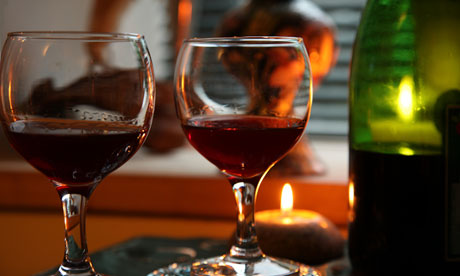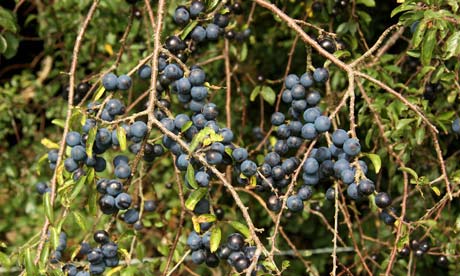How to make sloe gin
For a drink with only three ingredients, sloe gin is the subject of an unfeasibly large body of advisory literature. The key, however, is patience.

An 18-year-old sloe gin. Photograph: John Wright
Of all the alcoholic drinks that can delight and engage the home-brewer none engenders more discussion, argument, speculation, recipes and experimentation than sloe gin. Considering the earnest secrecy with which people guard their sloe patches, one would think the blackthorn (on which sloes grow) to be a rare tree and not the common inhabitant of hedgerows nearly everywhere that it is. No doubt it is the urban forager that has a hard time of it.
A blackthorn in full fruit is a remarkable sight with the fruit clustered densely around the branch like bunches of grapes. Attractive as the fruit looks the taste is worse than a disappointment. I often take people on hedgerow forays and rather delight in presenting each of my group with a sloe and asking them to chew in unison. Their mouths instantly fur up from the tannin and their faces screw up accordingly. A late, warm, wet spell can sometimes sweeten the fruit to bare acceptability, but only for the brave.
This season's weather has produced abundant and exceptionally fat, sweet sloes, so if you have always wanted to make sloe gin this year is as good as it gets. How you pick sloes is easily answered – carefully because of the vicious, sepsis-inducing spines from which the tree gets part of its Latin name – Prunus spinosa. When you pick them, however, is one of those issues that excite endless discussion – before the first frost or after? My view is to pick as late as possible but, provided the sloes are ripe (not bullet hard), it does not matter too much.
This season's weather has produced abundant and exceptionally fat, sweet sloes, so if you have always wanted to make sloe gin this year is as good as it gets. How you pick sloes is easily answered – carefully because of the vicious, sepsis-inducing spines from which the tree gets part of its Latin name – Prunus spinosa. When you pick them, however, is one of those issues that excite endless discussion – before the first frost or after? My view is to pick as late as possible but, provided the sloes are ripe (not bullet hard), it does not matter too much.
 Ripe sloes on the bush. Photograph: John Wright
Ripe sloes on the bush. Photograph: John Wright
Sloes have a chequered alcoholic history and sloe gin has only fairly recently achieved respectability as a bona-fide beverage. A (very long) polemical poem on British ills from 1717 refers disparagingly to beverages "... made at Home ... of Sugar, Sloes, and Grocer's Trash" and sloe-juice and gin was described, again scathingly, in 1838 as a mixture "which the inhabitants of London swallow for port." Sloe gin had to wait until the beginning of the 20th century before it became a drink that could speak its name. Now everyone, well everyone round here, makes it and is proud.
For a drink that has only three ingredients and which requires little more than putting them all in a jar at the same time, there is a surprising and rather intimidating wealth of advice available on precisely how to make the stuff. To this burdensome bounty I will add the most important advice of all – be patient, very patient. When I was writing my Hedgerow book a couple of years ago I did some extensive and selfless research on sloe gin making.
It was just before Christmas and I spent a late afternoon, and evening … and a bit of the night, visiting friends in my village who had invited me at one time or another to try their sloe gin. Unfortunately I left my notepad at the first house and the no-doubt invaluable wisdom imparted to me has unaccountably slipped from memory. One thing, however, that did impress itself on my impaired mind was that, no matter how the stuff was made, it's how long it's been kept that counts.
Most of what I was given was that year's vintage but my friend David presented me with glasses of sloe gin from three bottles – one a year old, one six years old and one, forgotten at the back of a cupboard and miraculously surviving the chaos of a house move, was old enough to vote. The youngest was pleasant, though the harshness of the alcohol was much in evidence. The middle-aged brew was a little more balanced but with quite a strong almond flavour – more likely from the sloes being left in the gin for longer than usual and extracting the stone flavours than from its age. The geriatric vintage, however, was a complete revelation. It far surpassed its younger cousins and all the others I had variously enjoyed that evening. The flavour was completely balanced and almost indistinguishable from a good Malmsey Madeira.
An 18 year project will not appeal to many, so you'll be pleased to hear that even an October brew drunk at Christmas is perfectly pleasant. Here is an extremely non-prescriptive recipe, I will leave you, dear reader, to adjust to taste.
About 500g ripe sloes
About 250g sugar (the more sugar you use the quicker the flavour comes out but, obviously, the sweeter it is)
About 1 litre of gin (any gin, or even vodka if you want a purer flavour)
About 250g sugar (the more sugar you use the quicker the flavour comes out but, obviously, the sweeter it is)
About 1 litre of gin (any gin, or even vodka if you want a purer flavour)
Prick the sloes with a fork (or don't, or put them in a freezer and then defrost them). Put them in a suitably sized Kilner jar, pour over the sugar and the gin, close the lid, shake, shake every day until the sugar has all dissolved, store in a dark cupboard, strain out the sloes through muslin after about three months, bottle, store in a dark cupboard, and wait.
No comments:
Post a Comment